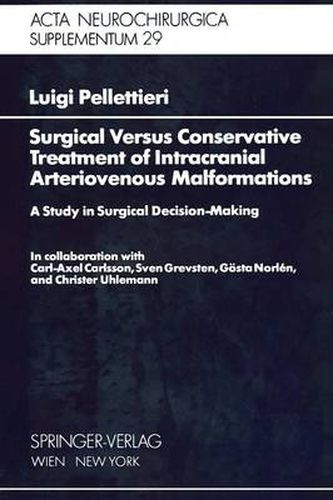Readings Newsletter
Become a Readings Member to make your shopping experience even easier.
Sign in or sign up for free!
You’re not far away from qualifying for FREE standard shipping within Australia
You’ve qualified for FREE standard shipping within Australia
The cart is loading…






This title is printed to order. This book may have been self-published. If so, we cannot guarantee the quality of the content. In the main most books will have gone through the editing process however some may not. We therefore suggest that you be aware of this before ordering this book. If in doubt check either the author or publisher’s details as we are unable to accept any returns unless they are faulty. Please contact us if you have any questions.
The main aim of this study is to define the clinical criteria which must be considered in order to come to an adequate decision whether a patient with intracranial arteriovenous malformation (AVM) should be operated upon or treated conservatively. A special method was used to reduce the effects of selection. This method made it possible to evaluate the therapeutic efficacy of conservative treatment versus surgery. The method implies that patients with equal combinations of variables (risk profiles) were compared in the two treatment lines. The variables building up the risk-profile pattern were chosen by analysing the decision process, as it was originally practiced by the surgeon who selected and treated the patients of this study. The risk profiles thus described relevant characteristics of the patient and his malformation. The variables were assigned numerical values accord ing to their prognostic value. Summation of the variables making up the risk profile then gives each risk profile a certain value. A low value symbolizes a bad prognosis and a high value a good prognosis in both treatment groups. There were many risk profiles with the same value in both groups and a comparison could be made over a large part of the risk-profile scale. This comparison showed that surgical treatment of A VM can always be justified, although the indications for surgery are less strong in patients with low risk profile values.
$9.00 standard shipping within Australia
FREE standard shipping within Australia for orders over $100.00
Express & International shipping calculated at checkout
Stock availability can be subject to change without notice. We recommend calling the shop or contacting our online team to check availability of low stock items. Please see our Shopping Online page for more details.
This title is printed to order. This book may have been self-published. If so, we cannot guarantee the quality of the content. In the main most books will have gone through the editing process however some may not. We therefore suggest that you be aware of this before ordering this book. If in doubt check either the author or publisher’s details as we are unable to accept any returns unless they are faulty. Please contact us if you have any questions.
The main aim of this study is to define the clinical criteria which must be considered in order to come to an adequate decision whether a patient with intracranial arteriovenous malformation (AVM) should be operated upon or treated conservatively. A special method was used to reduce the effects of selection. This method made it possible to evaluate the therapeutic efficacy of conservative treatment versus surgery. The method implies that patients with equal combinations of variables (risk profiles) were compared in the two treatment lines. The variables building up the risk-profile pattern were chosen by analysing the decision process, as it was originally practiced by the surgeon who selected and treated the patients of this study. The risk profiles thus described relevant characteristics of the patient and his malformation. The variables were assigned numerical values accord ing to their prognostic value. Summation of the variables making up the risk profile then gives each risk profile a certain value. A low value symbolizes a bad prognosis and a high value a good prognosis in both treatment groups. There were many risk profiles with the same value in both groups and a comparison could be made over a large part of the risk-profile scale. This comparison showed that surgical treatment of A VM can always be justified, although the indications for surgery are less strong in patients with low risk profile values.